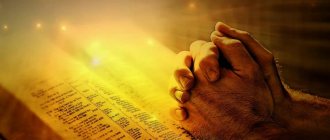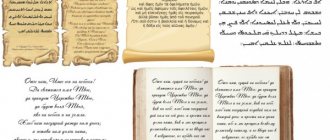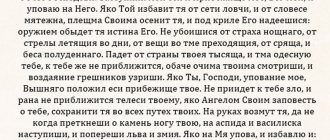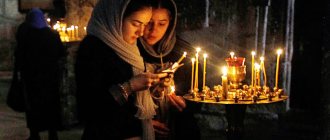Read a prayer in Hebrew online
To quickly find the desired text of the appeal to the Lord, online versions are provided. This makes the search task easier: you can always access the site, enter a search and go to the desired section. Another advantage is that you don’t have to carry an image of Jesus Christ with you. A version of the Lord's Prayer is also available for reading online.
אָבִינוּ שֶׁבַּשָּׁמַיִם
יִתְקַדֶּשׁ שִׁמְךָ,
תָּבוֹא מַלְכּוּתֶךָ,
Please contact us.
תֵּן לָנוּ הַיּוֹם לֶחֶם חֻקֶּנוּ
Please contact us ֲשֶׁר אָשֵׁמוּ לָנוּ.
About us
מִן הָרָע
The Lord's Prayer in Hebrew (in Russian letters)
When the opportunity arises to move to another country, it is better to first turn to the Lord, reading foreign prayer words, but in Russian letters. This helps to develop an understanding of pronunciation features. If you immediately try to pronounce foreign prayer words, obvious mistakes may occur. Because of this, turning to God is done with the wrong message. This will not shorten the distance between the person praying and God.
Avinu, schebashamayimYitkadesh shimkha
Tavo malkuteha
Yease rtzonkha ba-arets ka-asher na-asa vashamayim
Ten-lanu hayom lehem hukeynu.
U-selah lanu et ashmateynu, ka-asher solehim anahnu la-asher ashemu lanu.
Ve-al-tevieinu lidei massah, ki-im hatzileinu min-hara.
Ki lekha
Ha-mamelaha
Ve-hag'vura
Veha-tif'eret le-olmei olamim.
Amain
Send this prayer to your loved ones
LiveInternetLiveInternet
Transcription and translation
Avvun dbishmaya / Our Father, who art in heaven! nitkaddah shimmukh / Hallowed be Your name! little aunt / Thy kingdom come; neve sovyanukh / Thy will be done eichana dbishmaya ab para / as in heaven and on earth. Ha la lahma dsunkanan / Give us our daily bread yumana / this day. Vushyuh lan khobein / And forgive us our debts, eichana dap akhnan / just as we also leave Shuklan Khayavin / as our debtor. vula taalan lnisyuna / And do not lead us into temptation, ella pasan min bisha. / but deliver us from the evil one: mudtul dilukh hai / For yours is a boy / the kingdom of ukheil / and the power of utishbay / and glory to l'alam allmin. / forever and ever Amin. / Amen
- The Lord's Prayer “Our Father” in ancient Greek (Audio, mp3, 174 KB)
Πάτερ
Πάτερ ἡµῶν ὁ ἐν τοῖς οὐρανοῖς, ἁγιασθήτω τὸ ὄνοµά σου, ἐλθέτω ἡ βασιλεία σου, γενηθήτω τὸ θέληµά σου, ὡς ἐν οὐρανῷ καὶ ἐπὶ γῆς. ? ? αὶ µὴ εἰσενέγκῃς ἡµᾶς εἰς πειρασµόν, ἀλλὰ ῥῦσαι ἡµᾶς ἀπὸ τοῦ π ονηροῦ.
Transcription and translation
PATER imOn - Our Father O en tis Uranis - In the heavens AgiastIto to Onoma su - Let Your Name be sanctified EltAto and vasIlia su - Let Your Kingdom come Gennet Ito to to Telima su - Let Your will come true Os en urano ke Epi gis —- As in the sky and on earth Ton Arton imOn ton epIusion —- Our daily bread Dos imIn simeron —- Give us today Ke Afes imInta ofeilimata imOn —- And leave us our debts Oske imis afikamen —- As we left Tis ofIletes imOn —- To our debtors k mi isenkis imAs is pIrasmon —- And do not lead us into temptation Alla rrise imAs aPO tu poniru —- But deliver us from evil (Matthew 6:9-13)
- The Lord's Prayer “Our Father” in Latin (Audio, wav, 455 KB) Read by Pope Pius XII.
Pater
Pater noster, qui es in caelis, sanctificetur nomen tuum. Adveniat regnum tuum. Fiat voluntas tua, sicut in caelo et in terra. Panem nostrum quotidianum da nobis hodie. Et dimitte nobis debita nostra, sicut et nos dimittimus debitoribus nostris. Et ne nos inducas in tentationem, sed libera nos a malo. Amen.
Transcription and translation
Pater noster, qui es in chelis - Our Father who dwells in heaven. sanktifichEtur nomen tuum. - Hallowed be Thy name adveniat renyum tUum. - Thy kingdom come fiat volYuntas tua - Thy will be done sikut in chElo in terra. - both in heaven and on earth panem nostrum cotidiAnum - our daily bread and nobis Odie. – give us today et demitte nobis debita nostra – and leave us our debts sikut et nos demIttimus – just as we leave debitOribus nostris. - our debtors do not have a nose indukas - and do not lead us into intentions - into temptation Sed Libera nose a little. - but deliver us from evil Amen - Amen
- The Lord's Prayer “Our Father” in Hebrew (Audio, mp3, 142 KB)
| אבינו שבשמים יתקדש שמך Yes, please, please, please. Please contact us, please contact us כפי שסולחימ גם אנחנו לחוטאים לנו. ואל תביאנו לידי נסיון, כי אם חלצנו מן הרע. |
| Transcription and translation Avinu, shebashamayim - Our Father, in heaven Yitkadesh shimkha - Your Name will be sanctified Tavo malkutekha - Your Kingdom will come Yease rzonkha - Your will will be fulfilled Kabashamayim ken baaretz - as in heaven, also on earth Et lehem hukeinu - our constant bread Ten lyanu hayom - give us today Uslyah lyana al khataeynu - and forgive us our debts Kmo shesolhim gam anakhnu - just as we forgive Le hotim lyana - those who sin against us Veal tvieinu liyaday nisayon - do not let us fall into the power of temptation Ki im khaltsenu min hara - but save us from evil Ki leha hamamlakha - because Your Kingdom is Vehagvura - and the power of Vehatif'eret - and the glory of Leolmei - olyam. |
https://www.pravkniga.ru/molitvamp3.html
Download “Our Father” in Hebrew to your phone and print
The site presents different versions: for Android, iOS platforms. This allows you to download the appropriate version of turning to Jesus. If you save it in your smartphone, you can turn to God always and everywhere, without searching for prayer words. It is also possible to print the appeal in the most common format - A4. This is a necessary measure when studying the text. In the future it will be possible to read the text online.
Send this prayer to your loved ones
Send this prayer to your loved ones
Three daily prayers
Jewish law requires us to pray three times a day: morning, afternoon and evening. These prayers are called respectively - shacharit (morning prayer), mincha (midday prayer) and arvit or maariv (evening prayer).
Our sages say that the custom of praying three times a day was first introduced by our patriarchs - Abraham, Isaac and Jacob. Abraham introduced morning prayer, Isaac introduced midday prayer, and Jacob added evening prayer.
The book of Zohar (which reveals the inner meaning of the Torah) and the teachings of Chabad further explain that each of the three patriarchs is a representative of a special category, introduced by him into the service of G-d. Abraham served G-d with the category of love; Isaac - the category of reverence; Jacob - mercy. This must be understood not in the sense that each of them was deprived of other spiritual qualities, but that each of them especially manifested this particular quality characteristic of him. So Abraham was particularly distinguished by the categories of mercy (חסד) and love (אהבה), while Isaac was particularly distinguished by the categories of strict justice (דין) and reverence (יראה), and Yaakov inherited these categories and created a new quality from them, combining the first two categories into a well-harmonized lasting quality of truth (אמת) and mercy (רחמים). We, the children of Abraham, Isaac and Jacob, have inherited all three of these categories from our patriarchs, and this allows us to serve and pray to G‑d with love, reverence and mercy. The category of mercy manifests itself when we realize that our soul is a particle of G‑d and we are overcome with a feeling of pity for it because it is so often distracted from G‑d by the material affairs of everyday life.
When the Torah was given to us on Mount Sinai, our way of life was established for us by G-d. Torah means “teaching”, “instruction”, “guidance”, for the Torah teaches us how to behave in each individual case of life. The Torah contains 613 covenants, including the covenant to “serve G‑d with all our hearts and all our souls.” How do we serve G-d with our hearts? With our prayers. By doing this we fulfill not only the commandment commanding us to pray to G‑d, but also other commandments, such as loving G‑d and fearing Him, which are separate commandments.
For about the first thousand years after Moshe Rabbeinu, prayers were not ordered. Every Jew was obliged to pray to G‑d every day, but the form of prayer and how many times a day to pray was left to be decided by each Jew individually.
In the Temple, a firm order of service was established in connection with daily sacrifices in the morning and evening, and the evening sacrifice covered part of the night. On special days, such as the Sabbath and holidays, there were also additional sacrifices. Therefore, it was perhaps not unusual for individual Jews to pray morning, noon and evening, each in his own special way. David, for example, mentions that he prays three times a day, and Daniel (in Babylonia) prayed daily three times a day, facing the direction of Jerusalem. There is evidence that during the First Temple there were public houses of worship, which the Chaldeans (Babylonians) destroyed at the same time as the destruction of the Temple in Jerusalem.
After the destruction of the Temple and the exile of the Jews to Babylon, Jews continued to gather and hold joint prayers. Houses of worship became like “small sanctuaries.” But during the many years of exile, children born and raised in Babylonia were deprived of an accurate knowledge of the Holy Language (Hebrew) and spoke a mixed language. Therefore, when the Jews returned to their homeland after seventy years of exile, Ezra the Scribe, together with the Men of the Great Assembly (120 prophets and sages), developed the text of daily prayers and established as a permanent institution and obligation in Jewish life to read these prayers three times a day every day. Since then, the obligation imposed on each Jew individually to pray in an established manner and according to an approved text three times a day has become part of Jewish law, in accordance with the daily sacrifices in the Temple, with additional prayers on Saturday, Rosh Chodesh and holidays and a special “final” prayer on Yom -Kippur.
Thus, the main parts of daily prayers were formulated by our sages. This includes the prayers: Shema and Shemona Esre, which are still the main parts of our morning and evening prayers, and Shemona Esre is also the main part of the Mincha prayer. The chapter of Psalms chanted every day by the Levites in the Temple is part of our morning prayers. A number of other psalms of David were also included in the morning prayer and special blessings were added before and after the Shema. At the time of the composition of the Mishnah, Rabbi Yehuda Ha-Nasi (c. 3910 years p.s.m., approximately 500 years after Ezra) and especially at the time of the conclusion of the Talmud (approximately 300 years later, or ca. 1500 years ago) was already The basic structure (sidur) of our prayers in its modern form has been finally established.
Listen to “Our Father” in Hebrew online for free
Many people perceive information much better through sound vibrations than during reading. In addition, listening to the recording in audio format will help you remember it faster. This method is more suitable for children. You can also include a recording for people who cannot pray on their own. This option is suitable for people who have lost their legal capacity, patients after surgery, or with exacerbation of chronic diseases. Relatives can include a recording, which will help improve the person’s physical and mental condition.
Siddur
The Siddur is our traditional prayer book that contains all three daily prayers, as well as prayers for Shabbat, Rosh Chodesh and holidays. “Sidur” means order, order, for in the siddur our prayers are arranged in the proper order, established once and for all. Sometimes, for the sake of convenience, prayers for Shabbat and Rosh Chodesh are printed separately, in a separate siddur. Prayers for Rosh Hashanah and Yom Kippur are usually found in separate books called mahazor (“cycle”). Sometimes prayers for the “Three Holidays” - Passover, Shavuot and Sukkot - are also published in separate books.
The earliest siddur that has come down to us is the Siddur of Rav Amram Gaon, who was the head of the yeshiva of the city of Sura in Babylonia ca. 1100 years ago. He prepared this siddur at the request of the Jews of Barcelona (Spain). The Siddur contains the prayers in proper order for the entire year, including also some laws regarding prayers and customs. The Siddur was copied and used not only by the Jews of Spain, but also by the Jews of France and Germany, and generally became the generally accepted prayer book for all Jewish communities everywhere. The Seder of Rav Amram Gaon remained in manuscript for about 1,000 years until it was first printed in Warsaw in 1865.
Rav Saadya-Gaon, who was the head of the yeshiva in the same Sura ca. hundred years after Rav Amram Gaon, compiled a siddur for the Jews of Arab countries with explanations and instructions in Arabic. The Rambam (Rabbi Moshe ben Maimon, also known as Maimonides), in his famous Code of Jewish Law, also prepared the order of prayers for the entire year and placed them under the section Laws on Prayer. One of the oldest siddurim worthy of mention is also Mahazor Vitri, composed by Rabbi Simcha Vitri, who was a student of the great Rashi, and completed by him in 1208.
Nusah
Nusah means "style" or "variant" and sometimes also refers to min'ag, which means "custom" or "ritual." When we pick up a siddur, we find in it instructions on the title page about the nusach or min'aga to which this siddur relates, such as: nusach Sepharad (Spanish version), nusach Ashkenaz (Polish version), nusach Ari (option the learned saint Rabbi Isaac Lurie), etc.
It is clear that the main part of all prayers is the same in all different siddurim; there are only certain differences in the order of some prayers, and there is also a slight difference in the text of some additional poetic hymns composed by holy authors.
According to the explanation of the Magid from Mezhirich, there are at least 13 different nusakhot or min'agim in prayers. Each nusach represents one of the tribes or is a “gate,” and the ARI composed a common nusach, a “gate,” through which every Jew can pass to appear before the face of G‑d.
The first printed siddur had the title min'ag Romi (Roman or Italian Jews). It was printed in Soncino (Italy) in I486. The first siddur nusach Ashkenaz was printed in Prague in 1513 (the second part - in 1516), and the first siddur nusach Sepharad was printed in Venice in 1524. At one time, many siddurim were printed according to the customs of Poland, Romania, the Balkans and others countries with different nusahot. When the holy Rabbi Yitzchak Lurie (Ari) compiled a siddur according to the teachings of Kabbalah, many communities began to use it, and new series of siddurim nusach Ari were printed. Printers were not always accurate when printing, and therefore typos were not uncommon. Finally, the great Rabbi Schneur Zalman of Lyada, who was famous for his knowledge of both the Talmud and Kabbalah, reviewed about 60 different siddurim and developed his nusach based on the original nusach of the Ari; this nusach is now known as Nusach Chabad.
Latin transcription
This method of learning helps to avoid mistakes when pronouncing words. It is used at the stage of familiarization with an unfamiliar language. First, you can master the version written in Russian letters. After this, you can read the Latin transcription.
| In Russian | Latin transcription |
| Avinu, schebashamayimYitkadesh shimkha Tavo malkutekha Yease rtzonkha ba-arets ka-asher na-asa vashamayim Ten-lanu hayom léchem hukeynu. U-selah lanu et ashmateynu, ka-asher solehim anahnu la-asher ashemu lanu. Ve-al-tevieinu lidei massah, ki-im hatzileinu min-hara. Ki lekha Ha-mamelakha Ve-hag'vura Veha-tif'eret le-olmei olamim. Amain. | Avínu shebáshamáyim, Yítkadésh shimhá. Tavó Malkhutéha, Yeasé Retsóneha, ba-árets ka-ashér na-asá vashámayim, Ten-lánu haiyóm léhem hukéynu. U-seláh lánu et ashmatéynu, ka-ashér solehím anáhnu la-ashér áshemu lánu. Ve-ál-teviéynu lidéy massáh, ki-ím hatzileynu min-hará. Ki lehá ha-mámelahá ve-hágevurá vehá-tif-éret, le-óleméy ólamím Améin. |
Unity
The highest step of the prayer “ladder” is reached by us at the moment when we are so inspired that all desires leave us; All that remains is the feeling of unity with G‑d. At this level, tefillah corresponds to the concept of the verb tofel, “to attach,” or “to join,” or “to connect,” as two pieces of broken dishes are joined together in order to restore them again.
Our soul is truly “a part of the Divine above” and therefore it longs to reunite and be reabsorbed into the Divine, just as a small flame is consumed by a large flame that is near it. We may not be aware of this yearning of the soul, but it exists nonetheless. Our soul is therefore called “the lamp of G‑d.” The candle flame is constantly in motion, striving upward, wanting to break away from the wick and the candle itself; for it is the nature of fire to strive upward. Our soul also strives upward, like the flame of a candle; that is its nature, whether we are aware of it or not. This is also one of the reasons why a Jew sways during prayer. For prayer is the means by which we unite with G‑d through complete spiritual unity, so to speak, “soul to soul,” while our soul trembles and strives upward to unite with G‑d.
Let's look at this idea a little closer.
Every mitzvah commanded to us by G-d is fulfilled by us as a sacred decree; Thus, the mitzvah connects us with G‑d. The word mitzvah (מצוה) comes from the (Aramaic) word tsavta, which means “together with” or “in the company of someone.” We also find something similar to this in the Russian language. The word “oblige” carries within itself the concept of “connection” - the obligator is connected directly with the performer, regardless of the distance in space, position, state, etc. that exists between them. When a king or chief commands the youngest servant to do something, it immediately creates a bond between both of them. The humble servant feels very honored that the king or chief has taken notice of him and commanded him to do something, and that he, such an insignificant person, is able to do something like that to satisfy the desire of a great man. This makes the servant strive with all his might to be worthy of the attention and mercy of his master.
This applies to any commandment, especially to prayer. For nothing brings a person closer to G‑d than prayer, when the one praying sincerely pours out his soul before G‑d and this leads to the “unity of souls,” as mentioned earlier. If any mitzvah brings us closer to G-d, then prayer (at the level we are talking about here) brings us, as it were, into the arms of G-d. She gives us a wonderful elation and bliss, higher than which there is no joy and pleasure.
Prayer, we said, is a “ladder” consisting of a series of rungs. To reach the highest of them, we must start from the bottom and work our way up. In order to be able to do this, our prayers were composed prophetically by our prophets and ancient sages and are also arranged in the form of a “ladder”, invariably leading us to a high and ever-rising inspiration. We must therefore become familiar with our prayers and, first of all, know their ordinary meaning, and then the deeper meaning embedded in them, and finally become familiar with the entire system of our synagogue and individual services.











